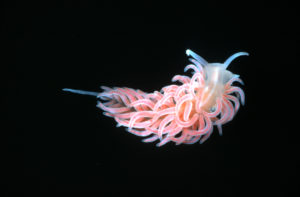Environmental DNA for mapping biodiversity, detecting pests and characterising food-webs

A pretty pink slug like marine creature covered in tentacles.
A nudibranch – Phyllodesmium serrata. The name Nudibranch means naked gills.
This project is now complete and you can read the abstract of the final report here.
Understanding the distribution and abundance of organisms is a central focus of biological science, and underpins almost all environmental management. Yet, in practice detecting and identifying organisms in the environment remains extremely challenging, particularly across large ecosystems.
Environmental DNA (eDNA) analysis is an emerging molecular technique for DNA-based identification of organisms.
Use of eDNA methods and analysis means that organisms can be detected and identified without capture or observation, even if they occur at low densities. These methods have the potential to transform the collection, analysis and use of biological data as well as increase our understanding of how ecosystems function and how they can be managed.
This project will showcase the application of eDNA methods using five case studies across freshwater and marine ecosystems and evaluate eDNA’s capacity to provide meaningful biological information to support practical decisions.
Project lead: Dr Gavin Rees
